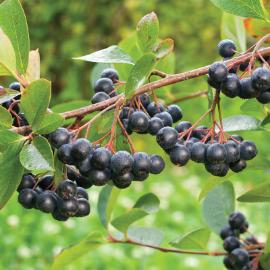Berry fruits have shown considerable potential in the food industry and nutrition science community over the last two decades due to the high level of phenolic compounds (e.g. anthocyanins) they possess and the role these compounds play in maintaining health and preventing disease 6. Epidemiological studies have demonstrated a correlation between consumption of fruits and vegetables with reduced incidence of obesity, diabetes and certain types of cancer 3-5 , making increased consumption of fruits, such as berries, an ideal target for nutrition intervention.
Figure S2. Images of (A) A. melanocarpa in fields during summer-time (B), bushes with fruits, (C) fruits & leaves and (D) the chemical structures of some of the potent bioactive compounds present in A. melanocarpa. In this study, men with mild hypercholesterolemia consumed 250 mL of the fruit juice for 3 weeks and achieved significant metabolic changes ( 40 ). It is important to note that regular consumption of A. melanocarpa is recommended even for people already on statin therapy ( 47 ). The main conclusion of this study was that anthocyanins are the most probable bioactive components responsible for the observed beneficial effects in A. melanocarpa.
Inhibition of ACE activity has been attributed to anthocyanidins and flavonoids which are all highly abundant in A. melanocarpa. More recently, the study by Bhaswant et al. ( 23 ) found similar beneficial effects on parameters related to the metabolic syndrome in rats fed with either Aronia melanocarpa juice or purple maize flour. Interestingly, reduction in SBP and DBP was more significant when a period of regular consumption of A. melanocarpa berry juice was followed ( 39 ). Another study by Broncel et al. ( 40 ) also demonstrated significant reductions in both SBP and DBP after 2 months of consumption of 300 mg of A. melanocarpa berry extract per day among patients with metabolic syndrome. Compositional details and bioactive compounds in Aronia melanocarpa fruits.
Due to the astringent taste of these fruits and their smell of bitter-almonds, pure A. melanocarpa products are not particularly popular among many consumers, although they have been documented as a functional food” in Russia since the 1940s. From this perspective, Aronia melanocarpa or black chokeberry has been investigated for its therapeutic properties in many studies, especially for its ability to combat hyperglycemia-induced oxidative stress and the macrovascular complications of diabetes including cardiovascular disease. Additional information on Aronia melanocarpa, prunifolia, or arbutifolia can be found on the link: USDA / NRCS PLANTS Database.
Chokeberry shrubs which are grown as bare root seedlings and transplants and sold both wholesale and retail with no minimum order. Aronia melancarpa 'Viking' is a beautiful shrub with a very flavorful fruit when used in juices, jams, and wines. X. Wu, L. Gu, R. L. Prior, and S. McKay, Characterization of anthocyanins and proanthocyanidins in some cultivars of Ribes, Aronia, and Sambucus and their antioxidant capacity,” Journal of Agricultural and Food Chemistry, vol.

No comments:
Post a Comment